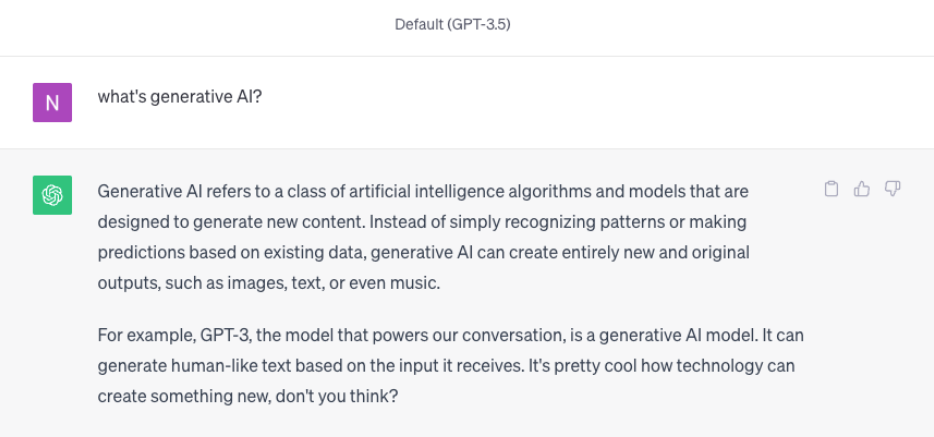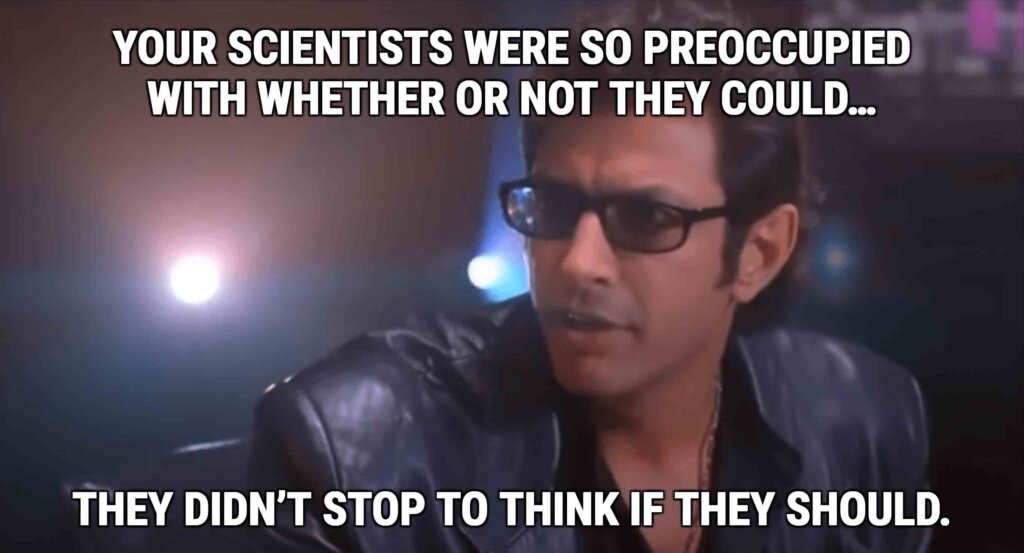Generative AI has been all the rage, and people are starting to talk more about its specific applications to sales enablement. Let’s dig in on what generative AI really is, what makes it different from existing AI solutions, and three distinct and popular use cases for how it may or may not affect the sales enablement world.
Generative AI - what is it?
Well, to start, I asked Open AI’s Chat GPT – here’s what it said:

Generative AI refers to a class of artificial intelligence algorithms and models that are designed to generate new content. Instead of simply recognizing patterns or making predictions based on existing data, generative AI can create entirely new and original outputs, such as images, text, or even music.
Now, we could just end the intro here and call it a day – but to bear down into our target use cases (and so we don’t get called out for lack of originality in our blog posts) I want to drill into two specific parts of that definition that are important:
- New and original outputs: Generative AI can “learn” from a compendium of existing information and create totally original outputs based on the information of those inputs. While this ‘new’ output can seem to be totally created by the algorithm, it’s important to remember that everything gen AI creates is solely based on what it’s trained upon. Which brings us to point 2…
- Based upon existing data: As google researchers announced last week, although the material that generative AI creates can seem brand new, any content it creates is just a reflection of the material it has been trained on. That means while it’s wildly helpful in creating content, it’s rarely going to be a silver bullet to create insights that don’t already exist.
With that in mind, let’s cover three use cases in sales and revenue enablement, and how generative AI might be a boom or bust to that area of the industry.
Use Case 1: Helping Sales reps finding content and information to share with a prospect
Background
Using the semantic information that Generative AI and LLM’s ‘learn’ in their training data, reps searching for content no longer have to use words or phrases inside of the content or metadata to find assets. Instead, they can ask questions of their content just like speaking to a human, and be directed to the relevant collateral without knowing what’s inside.
- Boom
This is a no brainer, right? This turns search on its head and basically turns your entire content catalog into an internal google, answering questions based on what reps need and not necessarily what they asked. And you don’t even have to buy a product! Throw your data into the cloud and you can build your own semantic search engine on top of your content.
Not only that, but when combined with other tools in your stack, reps can get content anywhere – slack, outlook, and other apps can support a back-and-forth for AE’s and SDR’s to find the content or knowledge that they need.
- Bust
While no one can doubt that asking semantic questions of your content makes searching easier, was the difficulty of searching really the thing holding reps back from using your content?
Generative AI won’t make a huge impact on sales content search because the use case boils down not only to the content that you find, but the context that you can deliver to the rep alongside the content. And while generative AI can absolutely be a help there (see Use Case 3 below), the specific scenarios that lead a rep to content mean that enablement is going to have to drive most of the summarization and external copy that a rep will need to be able to effectively share good information. While this may change the user interface to content-search tools, it won’t make a huge dent in the use cases that content serves.
Our Take
Organizations that have already invested in enabling reps by providing context to go along with content will be quick to take advantage of semantic-based LLM search, but it’s not going to be an instant fix for organizations that keep everything in SharePoint or Google Drive and have little supporting information for reps.
Use Case 2: AI-based training and on-demand coaching
Background
Due to their ability to easily summarize knowledge and present it in new ways, Generative AI models create a legitimate possibility to offer just-in-time, totally personalized training and coaching experiences. Integrating with call recording and message tracking software can even personalize based on performance in the real world.
- Boom
Imagine having a fully-loaded L&D specialist for every sales rep – because that’s practically the output that these models open up for enablement specialists. Just think of the possibilities! A near-endless supply of training content that’s not only personalized to the rep based on their performance, but also takes into account their preferences when consuming training material.
Consider a world where reps are everboarded into an organization through AI-generated best practices, and are consistently validating their messaging through objective pitch practice exercises being graded against the company’s brand and other top-competing reps. How could this not take off?
- Bust
Let’s take a step back from considering whether or not AI is going to help automate a lot of training and ask… should it?

Time and again, the most effective ways that reps learn are shown to be through both repetition and interaction with other reps, neither of which are truly enhanced through the application of generative AI. In fact, replacing in-person training with AI-created training exercises can absolutely be a detriment if not supplemented by more interaction or at least human supervision of call recordings.
On top of that, the coaching information that an LLM can provide is only as good as the training data it ‘learned’. Do you really have a compendium of product and brand training content that is good enough for an AI to both learn from and craft into new scenario-driven coaching content?
Our Take
While Generative AI is absolutely going to automate a lot of the repetitive tasks involved in creating base training material, it’s not going to provide a dramatic lift to learners in the short term given the amount of information we have on how people best learn and apply to their jobs. Organizations with well-defined training material may be sooner to realize benefit from these models than smaller organizations just beginning their L&D journey.
Use Case 3: Creating prospect-facing content
Background
For each sales cycle and prospect, Gen AI models can automate the messages in outreach for each sales rep. These can be anything from emails down to Linkedin DM’s – anything the sales rep would create and send off to their audience.
- Boom
Imagine getting over 30% more time in the day.
That’s what Generative AI will do once applied to email and prospecting, because that’s typically how much time salespeople waste writing and personalizing email copy for cadences. And we’re not losing anything by giving AI the wheel here – people are already creating personalized AI videos at scale, all with the same detail and attention a person would!
With more time available to them, reps are going to spend less time in pointless outreach and more time planning for the interactions that matter – getting in front of key accounts through in person and virtual meetings to drive more revenue.
- Bust
It’s boring, and it’s going away soon.
Seriously, check out any of the thousands of GPT email creators out there – they all sound exactly the same, with uninspiring copy trying to get me to book a demo with them.
Not only that, major inbox providers have already announced that they are drastically raising the bar for email engagement for mass senders – meaning that as soon as any AI-generated copy gets sent to spam, the company risks shutting down all outbound email.
Now, absolutely Gen AI is going to be instrumental in finding different ways to say something, or coming up with A/B test options. But automating prospecting and cadence writing is simply not feasible, and will not be for some time.
Our Take
This one could go either way. It looks promising, but it also looks unlikely. Setting a reminder for 2026 to revisit this to see how it went.
No One Knows For Sure, Not even aI
Although there are many use cases for Gen AI that have proven to add value, it’s not the answer quite yet. Human training and human-made content still continues to be consistently the better option, with AI offering help, but not fully taking over any Sales Enablement tasks right now.
Unfortunately, we don’t have the answers either, and in an attempt to provide original takes on the topic, our answer still remains the same as everyone else’s: For now a bust, but maybe a boom in the future? Only time will tell.




